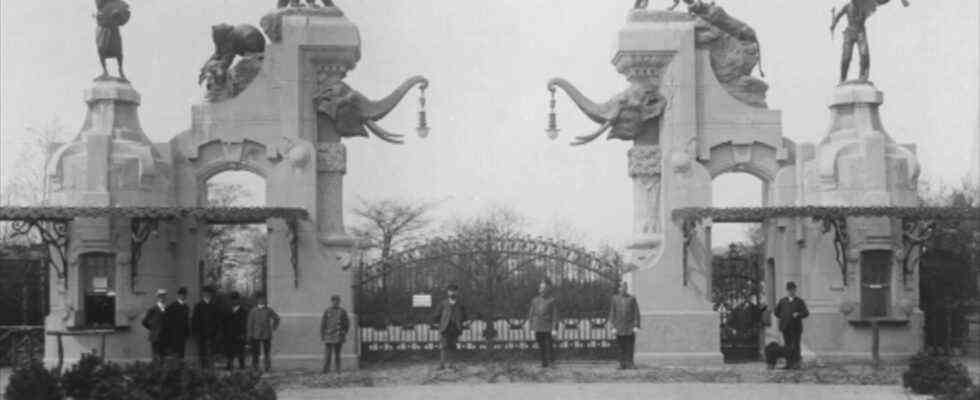Exclusive
As of: 10/26/2021 6:01 a.m.
The Hagenbeck Zoo in Hamburg is apparently having a hard time coming to terms with its Völkerschau past. Descendants of people exhibited at the time are finally calling for a critical discussion.
By Anne Ruprecht and Mirco Seekamp, NDR
It is an almost unknown story in this country that Christian Karembeu tells: Less than 100 years ago, his great-grandfather was presented as an alleged cannibal in a people show at Hagenbeck’s zoo. Karembeu is a French soccer star and became soccer world champion in 1998. In France he had drawn attention to the story of his great-grandfather years ago. In Germany, too, he would like to see a critical debate and reappraisal of this chapter.
Willy Karembeu, Christian Karembeu’s great-grandfather, came to the Hamburg zoo with a group of 30 men, women and children. Here they had to dance and swing their spears every day for visitors. They were supposed to build dugouts out of wooden trees, with which the visitors would later go for a walk on a pond.
Poster for a Völkerschau near Hagenbeck.
Image: NDR / Panorama
Enlisted with false promises
Willy Karembeu belonged to the Kanak people and comes from New Caledonia, a former French colony in the South Pacific. There he was recruited together with around 100 other Kanaks in 1931. Allegedly to represent her home in Paris at the colonial exhibition. Instead, as soon as they arrive in Paris, they are taken to the zoo of the Paris Jardin d’Acclimatation and displayed there as alleged cannibals. You have to utter wild screams, bar your teeth. “All visitors should be afraid,” says Christian Karembeu.
For Willy Karembeu and his group it was just a stopover. Shortly afterwards they are passed on to Hamburg, to Hagenbeck’s zoo, which advertises the group as the “last cannibals of the South Seas”. After a few weeks in Hamburg, the Kanak are so desperate that they send letters to the French colonial minister to ask for help. Even when it rains, they have to dance barefoot and almost unclothed for many hours a day, they report – “we don’t want to stay here any longer”.
Demands reappraisal: Christian Karembeu, grandson of the alleged “cannibal” that was exhibited in Hamburg.
Image: NDR / Panorama
In France, the matter soon became public and a scandal. The Kanak around Willy Karembeu are brought back from Hamburg to France and from there brought back to their homeland. His great-grandfather would not have let go of these experiences until his death, says Christian Karembeu, “they felt like slaves”.
Also positive memories of Völkerschauen
When Mattis Haetta reports how his father was exhibited at a Völkerschau in Germany, it sounds completely different. “I am very happy that he came out into the world,” he says. Daniel Haetta was Same and was presented together with a group of around 30 Sami including reindeer, dogs and sledges in Germany in 1930 in the so-called “Riesen Polarschau”. It was organized by the company Ruhe from Alfeld in Lower Saxony, a competitor to Hagenbeck. Historical research shows that seeds at Hagenbeck’s Völkerschauen had similar experiences as Daniel Haetta.
The seeds appearing at a competing Völkerschau felt that they were treated well, according to their own statements.
Image: NDR / Panorama
Mattis Haetta also explains that his father had positive memories of the Völkerschau by the fact that the Sami, as an indigenous people, were very culturally suppressed in Norway at that time. In Germany, they would have enjoyed the attention given to their culture. In addition, they were well paid. The father did not feel that he was exhibited. Daniel Haetta’s granddaughter is more skeptical. The photos looked very exotic and strange compared to how she knew her grandfather and her culture, says Susanne Haetta. Above all, she finds the display of people problematic from today’s point of view. However, she believes the Sami were portrayed more positively than other cultures, “as a kind of romanticized idea of savages”.
The zoo and the difficult process
The zoo is apparently having a hard time with the processing. Last year there had already been protests related to the Völkerschau past. At that time, Hagenbeck initially responded defiantly: “The zoo is proud of its founder and it will stay that way,” it said. Shortly afterwards, however, a public review was announced.
In response to questions from Panorama 3 there was no answer to the Kanak presented as cannibals. An interview in front of the camera was also not possible. The zoo only refers to the processing announced a year ago, which has not yet been completed. Therefore, one does not want to comment at the moment. In a statement, the company writes that Völkerschau participants “worked as actors with contracts and fees for Hagenbeck, today comparable to artists and jugglers in the circus or in the vaudeville”. They also emphasize that Hagenbeck has always seen them as guests and never mistreated them.
Founder Carl Hagenbeck saw the exhibited people as “guests”.
Image: NDR / Panorama
Zoo founder Carl Hagenbeck is considered to be the largest organizer of Völkerschauen in Europe. In 1874 Hagenbeck began to send people from other cultures on tours through Germany, but also to other countries. After his death this was carried on by his sons. The 1931 Kanak Völkerschau was Hagenbeck’s last. At times, the family company was only able to keep afloat by doing business with the Völkerschauen.

